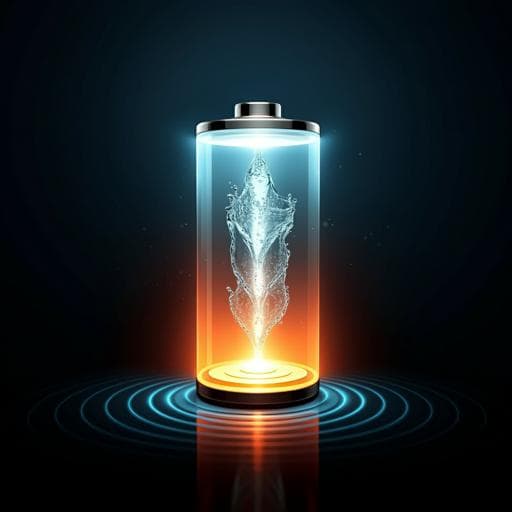
Chemistry
A chemically self-charging aqueous zinc-ion battery
Y. Zhang, F. Wan, et al.
Discover the groundbreaking advancements in self-charging power systems with chemically self-charging aqueous zinc-ion batteries developed by Yan Zhang, Fang Wan, Shuo Huang, Shuai Wang, Zhiqiang Niu, and Jun Chen. This innovative system simplifies energy harvesting and storage, demonstrating remarkable efficiency and functionality in various charging modes.
~3 min • Beginner • English
Introduction
The recharging of conventional batteries is constrained in remote or harsh environments where access to the electrical grid is unavailable. Prior self-charging power systems combine energy harvesters (e.g., photovoltaic, piezoelectric, triboelectric, thermoelectric) with batteries, but they are resource-dependent and require complex multi-component configurations. Chemical energy in ubiquitous oxygen offers an alternative energy source for direct conversion via redox reactions. Vanadium-based compounds have emerged as promising cathodes for aqueous zinc-ion batteries (ZIBs) due to their open frameworks and multivalent vanadium, enabling Zn²⁺ insertion and vanadium reduction during discharge. Since reduced vanadium can be oxidized by oxygen, discharged vanadium-based cathodes could, in principle, be re-oxidized by ambient O₂, effecting a chemical self-charging process without external electricity. Motivated by this, the study develops a chemically self-charging aqueous ZIB using a CaV₆O₁₆·3H₂O (CaVO) cathode in a simple two-electrode configuration that harvests chemical energy from air, converts it into electrical energy, and stores it in the battery, enabling self-recharge upon exposure to air.
Literature Review
Integrated self-charging systems typically rely on coupling batteries with energy harvesters such as solar cells, piezoelectric and triboelectric nanogenerators, or thermoelectrics. While effective, these systems depend on intermittent energy sources and add complexity (photoelectrodes, redox couples, control circuits). Metal–air batteries harness oxygen but, when integrated with storage devices, cannot continuously compensate consumption and still require external recharge when depleted. In aqueous ZIBs, vanadium-based cathodes (e.g., V₂O₅·nH₂O, zinc/alkali vanadates) offer high capacity and rate due to layered frameworks, interlayer water, and multivalence, showing reversible Zn²⁺ insertion/extraction and excellent cycling. Vanadium oxides are also redox-active toward oxygen, suggesting discharged vanadium cathodes may be chemically re-oxidized by O₂ and thus enable a direct oxygen-driven self-charging ZIB without ancillary components.
Methodology
Materials: NH₄VO₃, CaCl₂, SDS, PVDF, NMP, single-walled CNTs (SWCNTs), Zn foil, glass fiber separator, and Zn(CF₃SO₃)₂ electrolyte were used. Electrolyte (4 M Zn(CF₃SO₃)₂) was purified prior to use.
Synthesis of CaVO nanoribbons: A hydrothermal method was employed. 117 mg NH₄VO₃ was dissolved in 30 mL deionized water at 80 °C for 20 min. Separately, 666 mg CaCl₂ and 100 mg SDS were dissolved in 30 mL water at 60 °C for 10 min. The solutions were mixed under stirring, transferred to a 100 mL Teflon-lined autoclave, and heated at 160 °C for 10 h. Products were washed with water and freeze-dried. Morphology: nanoribbons hundreds of micrometers long, 200–500 nm wide. Structure: monoclinic CaV₆O₁₆·3H₂O (A2/m), layered with hydrated Ca as pillars; interlayer spacing (002) ~0.819 nm. Characterization: XRD with Rietveld refinement; TGA confirming 3 waters; SEM/TEM/HRTEM/EDS mapping; XPS; V K-edge XANES; in situ XRD; solid-state ¹H NMR.
Electrode fabrication: Cathode slurry composed of CaVO:SWCNT:PVDF = 7:2:1 (wt) in NMP, cast on stainless-steel mesh, dried at 60 °C (12 h, vacuum). Mass loading ~1 mg cm⁻². Anode: Zn foil (30 μm). Separator: Whatman GF/A glass fiber.
Cell assembly and testing: CR2032 coin cells with 4 M Zn(CF₃SO₃)₂ aqueous electrolyte. Galvanostatic charge/discharge (GCD) in 0.3–1.5 V window on LAND CT2001A. CV on CHI660E in same voltage window. Rate and cycling tests conducted up to 30 A g⁻¹ and 10 A g⁻¹ for 10,000 cycles.
Chemical oxidation/self-charging protocol: Cells were first discharged to 0.3 V at 0.1 A g⁻¹ to form CaZn₃.₆VO (i.e., Zn-inserted CaVO). Discharged cathodes were rinsed and immersed in 4 M Zn(CF₃SO₃)₂ or deionized water for controlled times (6–42 h) to react with dissolved O₂, then reassembled for electrochemical tests. XPS and XRD tracked vanadium oxidation state and interlayer spacing changes during O₂ oxidation.
Open-cell in situ chemical charging: "Open" coin cells were built with a drilled hole in the cathode cap covered by Kapton; after discharge, the Kapton was removed under >60% RH to allow O₂ diffusion for in situ chemical charging; after self-charging, the cell was resealed. Hybrid chemical/galvanostatic charging modes were evaluated.
Mechanistic analyses: In situ/ex situ XRD, ex situ TEM, XPS (V 2p, Zn 2p), V K-edge XANES, and control experiments in oxygenated acetonitrile (absence of H₂O) and neutral aqueous solutions assessed the roles of O₂ and H₂O in oxidizing CaZn₃.₆VO and extracting Zn²⁺. Formation of triflate-containing layered double hydroxide byproduct Znx+y(CF₃SO₃)₂y(OH)₂x was characterized (morphology and spectroscopy).
Key Findings
- CaVO nanoribbons (monoclinic CaV₆O₁₆·3H₂O, layered structure with hydrated Ca pillars) enable fast Zn²⁺ kinetics; initial discharge capacity 300 mAh g⁻¹ at 0.1 A g⁻¹ with ~0.7 V average voltage vs Zn²⁺/Zn; rate capability retains 62 mAh g⁻¹ at 30 A g⁻¹; capacity recovers upon lowering current (to ~290 mAh g⁻¹ at 0.2 A g⁻¹ after high-rate cycling).
- Ultra-long cycling stability: at 10 A g⁻¹ for 10,000 cycles, capacity remains ~170 mAh g⁻¹ with no degradation; initial activation observed over ~200 cycles.
- Electrochemical mechanism: Two-step redox (V⁵⁺/V⁴⁺ and V⁴⁺/V³⁺) during Zn²⁺ insertion/extraction seen in CV at ~0.95/0.75 V and 0.66/0.47 V; Zn 2p XPS confirms Zn intercalation/deintercalation; V K-edge XANES tracks vanadium valence changes.
- Chemical self-charging: Discharged CaZn₃.₆VO is spontaneously oxidized by dissolved O₂ in 4 M Zn(CF₃SO₃)₂, extracting Zn²⁺ to form CaZn₃.₆−xVO; O₂ reduction consumes H⁺ to form H₂O, driving water dissociation and generating OH⁻; byproduct Znx+y(CF₃SO₃)₂y(OH)₂x forms on the electrode surface.
- Time-dependent oxidation: XRD (002) peak shifts indicate interlayer spacing increases from 7.75 Å to 8.10 Å after 42 h oxidation; V 2p XPS shifts confirm vanadium oxidation; both changes saturate by ~36 h, indicating reaction completion within 36 h.
- Role of water: In oxygenated acetonitrile (no H₂O), no vanadium oxidation and no Zn²⁺ extraction occur; both O₂ and H₂O are essential. Reaction proceeds also in neutral aqueous solutions with formation of hydroxide/triflate LDH byproduct.
- Self-charging battery performance: After chemical charging (oxidation) for 36–42 h, Zn/CaZn₃.₆−xVO cells exhibit OCVs of ~1.05–1.08 V (approaching ~1.2 V initial OCV of fresh Zn/CaVO) and deliver discharge capacities up to ~239 mAh g⁻¹ at 0.1 A g⁻¹ (36 h). For oxidation <36 h, capacity increases with time; beyond 36 h, capacity declines due to accumulation of Znx+y(CF₃SO₃)₂y(OH)₂x impeding Zn²⁺ insertion.
- Reversibility and reusability: Chemical charging followed by galvanostatic discharge is reversible; stepwise variation of chemical charging time modulates capacity (e.g., 105.1 → 221.4 → 96.4 mAh g⁻¹). Repeated cycles show some capacity fade due to byproduct buildup and structural stress, but electrochemical charging decomposes much of the byproduct and restores performance.
- Open, in situ self-charging: "Open" coin-type ZIBs with an O₂ diffusion window self-charge in situ; OCV after chemical charging reaches ~0.77 V and can be recharged galvanostatically to 1.5 V when external power is available. Hybrid chemical/galvanostatic modes show minimal impact on subsequent GCD behavior; two self-charged cells in series power a timer display.
- Distinction from zinc–air batteries: O₂ participates only in the self-charging step (oxidizing the discharged cathode), not during discharge; Zn²⁺ intercalation into CaVO defines discharge, unlike Zn–air chemistry.
Discussion
The work addresses the challenge of recharging batteries without grid access by enabling direct chemical self-charging using ambient oxygen in a simple two-electrode aqueous ZIB. The CaVO layered cathode supports high-rate Zn²⁺ intercalation and exceptional cycling stability, while its reduced (discharged) state is thermodynamically capable of donating electrons to O₂, which is reduced in the aqueous electrolyte. This spontaneous redox restores the cathode to a charged state (vanadium oxidation with concomitant Zn²⁺ deintercalation), imparting self-rechargeability with OCV up to ~1.05–1.08 V and discharge capacity ~239 mAh g⁻¹. Mechanistic analyses confirm the essential roles of O₂ and H₂O, time-dependent structural expansion, and byproduct formation. The system operates reversibly across chemical and galvanostatic charge modes, including in situ self-charging in “open” coin cells, demonstrating practicality and compatibility with conventional charging. Compared to zinc–air batteries, this approach decouples O₂ chemistry from discharge and uses O₂ solely for self-charging, simplifying device architecture while preserving intercalation-based discharge behavior relevant to ZIBs. Limitations arise from irreversible Zn²⁺ consumption into a triflate-containing hydroxide layer during chemical charging and structural stress from repeated Zn²⁺ extraction/insertion; however, subsequent electrochemical charging decomposes much of the byproduct and can redeposit Zn²⁺ on the anode, partially mitigating degradation.
Conclusion
This study introduces a chemically self-charging aqueous zinc-ion battery based on a CaV₆O₁₆·3H₂O cathode that integrates chemical energy harvesting from ambient oxygen with energy conversion and storage in a conventional two-electrode design. The cells deliver high electrochemical performance (300 mAh g⁻¹ at 0.1 A g⁻¹; stable ~170 mAh g⁻¹ over 10,000 cycles at 10 A g⁻¹) and self-charge to ~1.05–1.08 V, providing up to ~239 mAh g⁻¹ discharge capacity after chemical charging. The self-charging process is reversible and compatible with hybrid chemical/galvanostatic operation, and can be realized in situ in open coin cells to power small electronics. Future research could focus on suppressing or managing the formation/accumulation of the Znx+y(CF₃SO₃)₂y(OH)₂x byproduct during chemical charging, optimizing electrolyte composition and pH buffering to steer ORR pathways, engineering cathode architectures to accommodate stress from repeated Zn²⁺ extraction/insertion, and accelerating O₂ transport/kinetics to shorten self-charging times while preserving capacity.
Limitations
- Chemical charging forms a triflate-containing layered double hydroxide byproduct (Znx+y(CF₃SO₃)₂y(OH)₂x) that irreversibly consumes Zn²⁺, increases impedance, and hinders subsequent Zn²⁺ insertion, leading to capacity degradation, especially when oxidation time exceeds ~36 h.
- Zn²⁺ ions are not redeposited on the Zn anode during chemical charging, limiting long-term chemical charging/galvanostatic discharging cycling without periodic electrochemical recharge to decompose byproducts and restore Zn.
- Structural stress from repeated Zn²⁺ extraction/insertion during chemical charging/discharging contributes to capacity fade over multiple cycles.
- Self-charging time to reach near-full OCV is relatively long (up to ~36 h to saturate oxidation under tested conditions).
Related Publications
Explore these studies to deepen your understanding of the subject.







